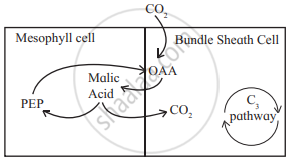Advertisements
Advertisements
प्रश्न
Answer the following question.
Why are plants that consume more than the usual 18 ATP to produce 1 molecule of glucose favoured in tropical regions?
उत्तर
- C4 plants are favoured in tropical regions as they require 30 ATP to produce 1 molecule of glucose.
- The high temperature in tropical regions leads to closure of stomata to reduce the rate of transpiration. Due to this availability of CO2 decreases.
- PEP carboxylase present in mesophyll cells can fix CO2 even at low concentration. This helps the plant inefficient assimilation of atmospheric carbon dioxide.
- C4 plants contain special leaf anatomy called Kranz anatomy which minimizes the losses due to photorespiration.
- It helps C4 plants to survive in conditions of high daytime temperatures, intense sunlight and low moisture.
APPEARS IN
संबंधित प्रश्न
C4 pathway is also called as dicarboxylation pathway because ______.
Answer the following question.
What are the steps that are common to C3 and C4 photosynthesis?
Answer the following question.
In C-4 plants, why is C-3 pathway operated in bundle sheath cells only?
Answer the following question.
What would have happed if C-4 plants did not have Kranz anatomy?
Answer the following question.
Why does RuBisCO carry out preferentially carboxylation than oxygenation in C4 plants?
Answer the following question.
How can you identify whether the plant is C3 or C4? Explain / Justify.
Answer the following question.
In C4 plants, bundle sheath cells carrying out the Calvin cycle are very few in number. Then also, C4 plants are highly productive. Explain.
Answer the following question.
What is the functional significance of Kranz anatomy?
Correct the pathway and name it.

Where does the conversion of pyruvic acid into phosphoenol pyruvic acid take place?
